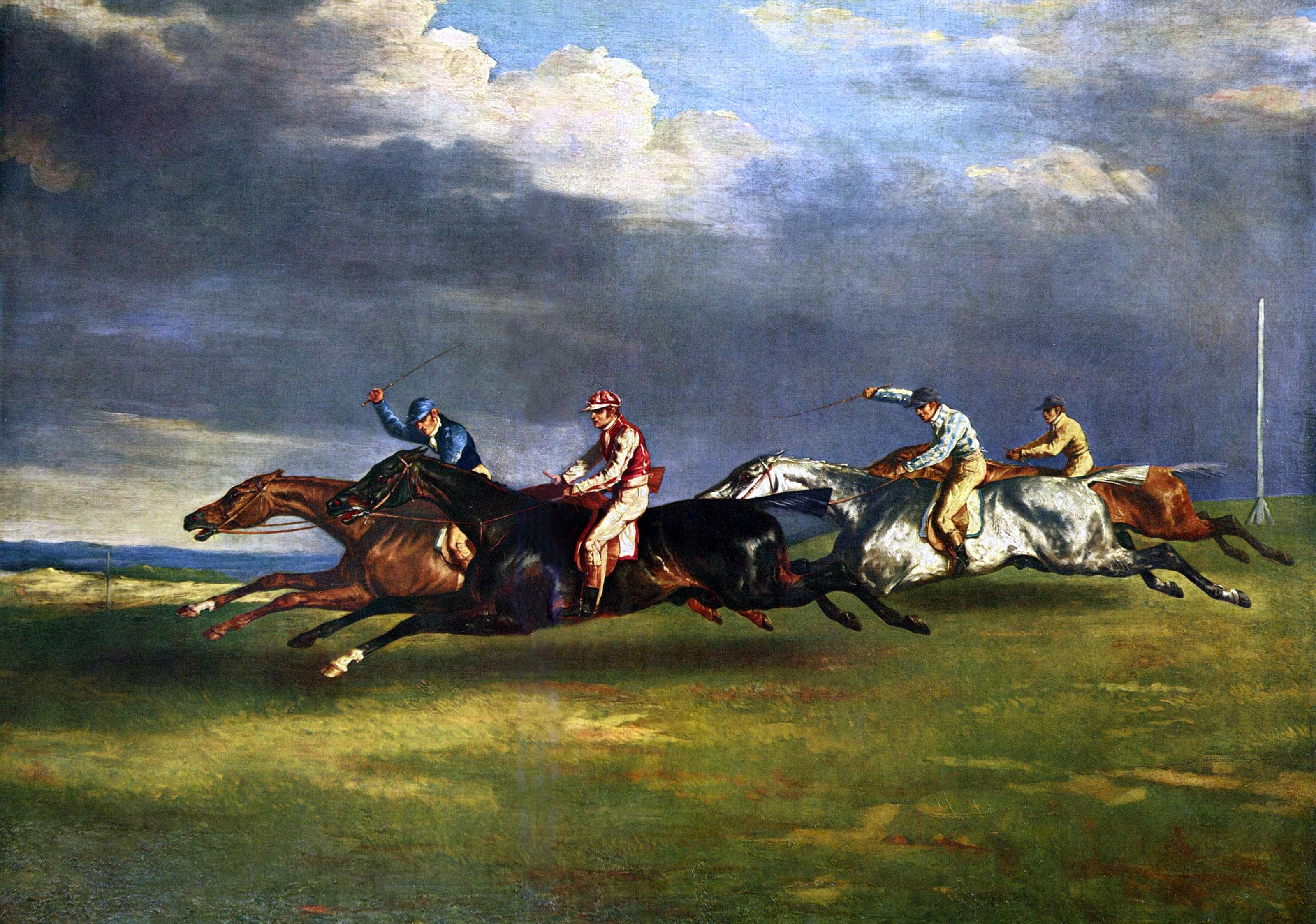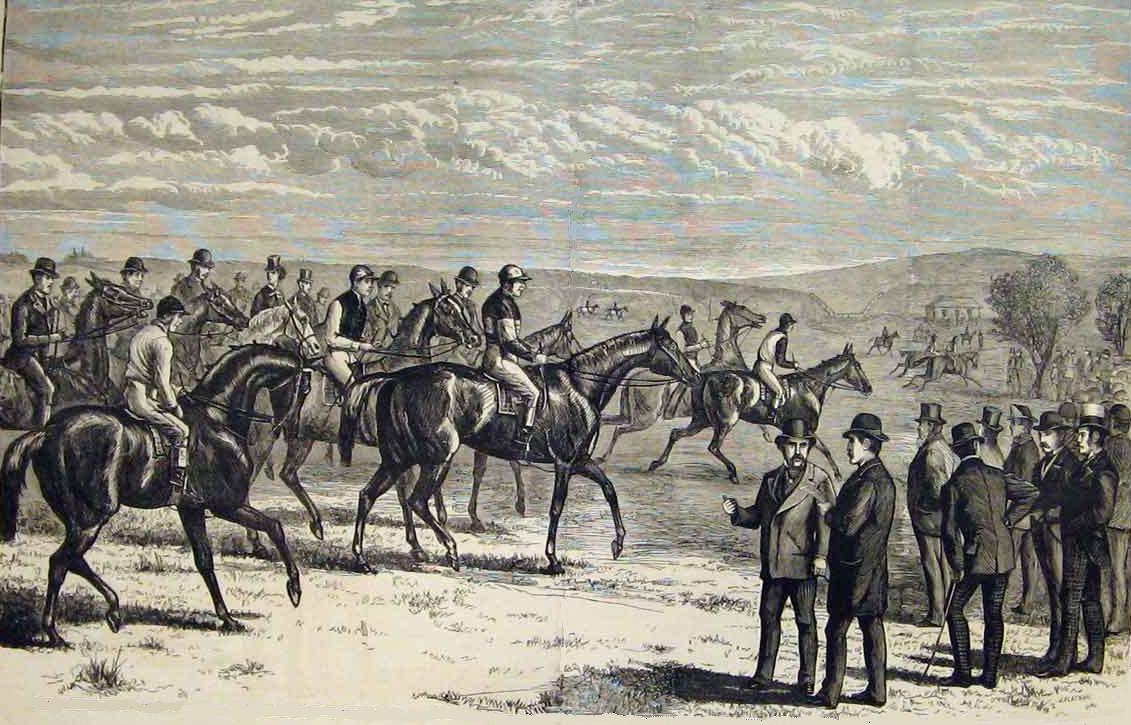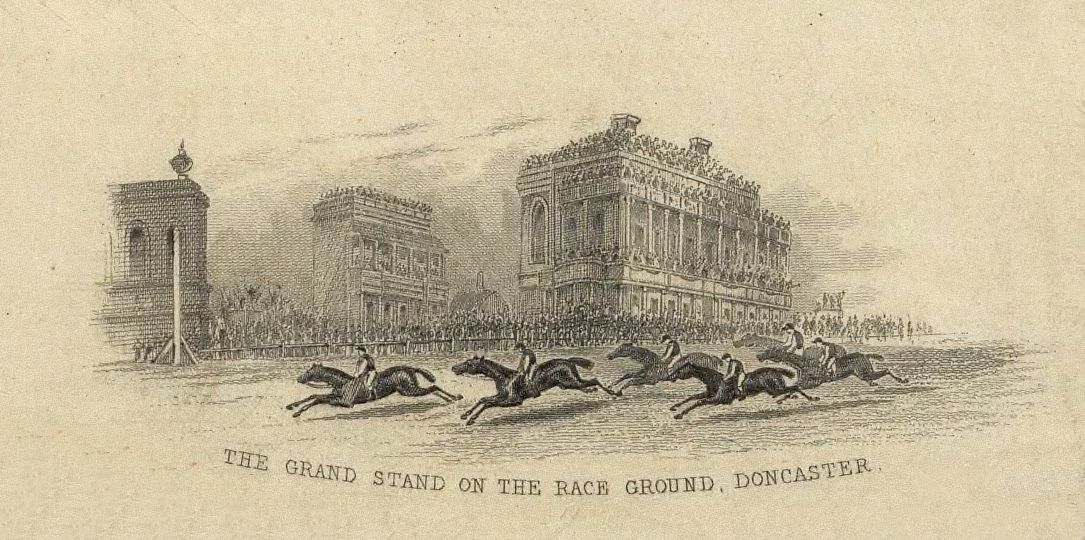|
Lemonora (horse)
Lemonora (foaled 1918) was a British Thoroughbred racehorse owned by Joseph Watson, 1st Baron Manton (1873-1922). Ridden by Joe Childs he won the Grand Prix de Paris on 26 June 1921, one mile seven furlongs, beating a large field, with a prize of 400,000 French Francs (about £16,830) then the world's most valuable racing prize. Just 26 days before on 1 June 1921 he came third in the Derby, having in early May come second in the Classic 2000 Guineas at Newmarket. In 1920 he won the Champagne Stakes at Doncaster and came second in the Gimcrack Stakes at York. His subsequent breeding career was disappointing as he was "a bad sire". The unusually feminine sounding name for a stallion appears to be from a variety of azalea created in 1912 whose flowers are "moderate yellow, tinted pink externally". Lemonora is immortalised in the 1935 Alfred Hitchcock Sir Alfred Joseph Hitchcock (13 August 1899 – 29 April 1980) was an English filmmaker. He is widely regarded as one o ... [...More Info...] [...Related Items...] OR: [Wikipedia] [Google] [Baidu] |
Joe Childs
Joseph Childs (1884–1958) was a French-born, British-based flat racing jockey. He won fifteen British Classics in a 35-year career, the last ten years of which were spent as jockey to King George V. He was known for riding a slow, waiting race, and also for having a short temper which regularly saw him at odds with his trainers and owners. Early life Childs was born in Chantilly into a racing family. His father had ridden successfully in France, and his grandfather had worked at the stables of Peter Price in Newmarket. There were also four brothers – Albert, Arthur, Charles and Henry – who all became jockeys. Joe would go on to be the foremost of these, but Charles would win the 1916 St. Leger on Hurry On, two years before Joe himself won it. Albert became a trainer in Marseilles, France. Childs was married to Emily Lavis (1887–1914) like Childs she was from a racing family, born in Chantilly and the daughter of racing trainer Alfred James Lavis, they had one child ... [...More Info...] [...Related Items...] OR: [Wikipedia] [Google] [Baidu] |
Epsom Derby
The Derby Stakes, also known as the Epsom Derby or the Derby, and as the Cazoo Derby for sponsorship reasons, is a Group 1 flat horse race in England open to three-year-old colts and fillies. It is run at Epsom Downs Racecourse in Surrey on the first Saturday of June each year, over a distance of one mile, four furlongs and 6 yards (2,420 metres). It was first run in 1780. It is Britain's richest flat horse race, and the most prestigious of the five Classics. It is sometimes referred to as the "Blue Riband" of the turf. The race serves as the middle leg of the historically significant Triple Crown of British horse racing, preceded by the 2000 Guineas and followed by the St Leger, although the feat of winning all three is rarely attempted in the modern era due to changing priorities in racing and breeding, and the demands it places on horses. The name "Derby" (deriving from the sponsorship of the Earl of Derby) has been borrowed many times, notably by the Kentucky D ... [...More Info...] [...Related Items...] OR: [Wikipedia] [Google] [Baidu] |
The 39 Steps (1935 Film)
''The 39 Steps'' is a 1935 British thriller film directed by Alfred Hitchcock and starring Robert Donat and Madeleine Carroll. It is very loosely based on the 1915 adventure novel '' The Thirty-Nine Steps'' by John Buchan. It concerns a Canadian civilian in London, Richard Hannay, who becomes caught up in preventing an organisation of spies called "The 39 Steps" from stealing British military secrets. After being mistakenly accused of the murder of a counter-espionage agent, Hannay goes on the run to Scotland and becomes tangled up with an attractive woman while hoping to stop the spy ring and clear his name. Since its initial release, the film has been widely acknowledged as a classic. Filmmaker and actor Orson Welles referred to it as a "masterpiece." Screenwriter Robert Towne remarked, "It's not much of an exaggeration to say that all contemporary escapist entertainment begins with ''The 39 Steps''." Plot At a London music hall theatre, Richard Hannay is watching a demonst ... [...More Info...] [...Related Items...] OR: [Wikipedia] [Google] [Baidu] |
Alfred Hitchcock
Sir Alfred Joseph Hitchcock (13 August 1899 – 29 April 1980) was an English filmmaker. He is widely regarded as one of the most influential figures in the history of cinema. In a career spanning six decades, he directed over 50 feature films, many of which are still widely watched and studied today. Known as the "Master of Suspense", he became as well known as any of his actors thanks to his many interviews, his cameo roles in most of his films, and his hosting and producing the television anthology '' Alfred Hitchcock Presents'' (1955–65). His films garnered 46 Academy Award nominations, including six wins, although he never won the award for Best Director despite five nominations. Hitchcock initially trained as a technical clerk and copy writer before entering the film industry in 1919 as a title card designer. His directorial debut was the British-German silent film '' The Pleasure Garden'' (1925). His first successful film, '' The Lodger: A Story of the London F ... [...More Info...] [...Related Items...] OR: [Wikipedia] [Google] [Baidu] |
Azalea
Azaleas are flowering shrubs in the genus ''Rhododendron'', particularly the former sections ''Tsutsusi'' (evergreen) and '' Pentanthera'' (deciduous). Azaleas bloom in the spring (April and May in the temperate Northern Hemisphere, and October and November in the Southern Hemisphere), their flowers often lasting several weeks. Shade tolerant, they prefer living near or under trees. They are part of the family Ericaceae. Cultivation Plant enthusiasts have selectively bred azaleas for hundreds of years. This human selection has produced over 10,000 different cultivars which are propagated by cuttings. Azalea seeds can also be collected and germinated. Azaleas are generally slow-growing and do best in well-drained acidic soil (4.5–6.0 pH). Fertilizer needs are low. Some species need regular pruning. Azaleas are native to several continents including Asia, Europe and North America. They are planted abundantly as ornamentals in the southeastern US, southern Asia, and parts o ... [...More Info...] [...Related Items...] OR: [Wikipedia] [Google] [Baidu] |
Gimcrack Stakes
The Gimcrack Stakes is a Group 2 flat horse race in Great Britain open to two-year-old colts and geldings. It is run at York over a distance of 6 furlongs (1,207 metres), and it is scheduled to take place each year in August. History The event is named after Gimcrack, a successful racehorse in the 18th century. Gimcrack won twenty-seven times in a career of thirty-six races, but none of his victories were achieved at York. The Gimcrack Stakes was established in 1846, and it was originally open to horses of either gender. It was restricted to male horses in 1987. The race is currently staged on the third day of York's four-day Ebor Festival meeting. The owner of the winning horse is traditionally invited to give a speech at the annual Gimcrack Dinner, which is held at the racecourse in December. Records Leading jockey (9 wins): * John Osborne, Jr. – ''Exact (1852), Coastguard (1863), Wild Agnes (1864), Lord of the Vale (1865 ... [...More Info...] [...Related Items...] OR: [Wikipedia] [Google] [Baidu] |
Newmarket Racecourse
Newmarket Racecourse is a British Thoroughbred horse racing venue in Newmarket, Suffolk, Newmarket, Suffolk, comprising two individual racecourses: the Rowley Mile and the July Course. Newmarket is often referred to as the headquarters of Horse racing in the United Kingdom, British horseracing and is home to the largest cluster of training yards in the country and many key horse racing organisations, including Tattersalls, the National Horseracing Museum and the National Stud. Newmarket hosts two of the country's five British Classic Races, Classic Races – the 1,000 Guineas and 2,000 Guineas, and numerous other Group races. In total, it hosts 9 of British racing's List of British flat horse races#Group 1, 36 annual Group One, Group 1 races. History Racing in Newmarket was recorded in the time of James VI and I, James I. The racecourse itself was founded in 1636. Around 1665, Charles II of England, Charles II inaugurated the Newmarket Town Plate and in 1671 became the fi ... [...More Info...] [...Related Items...] OR: [Wikipedia] [Google] [Baidu] |
2000 Guineas
The 2000 Guineas Stakes is a Group 1 flat race in Great Britain open to three-year-old thoroughbred colts and fillies. It is run on the Rowley Mile at Newmarket over a distance of 1 mile (1,609 metres) and scheduled to take place each year at the start of May. It is one of Britain's five Classic races, and at present it is the first to be run in the year. It also serves as the opening leg of the Triple Crown, followed by the Derby and the St Leger, although the feat of winning all three has been rarely attempted in recent decades. History The 2000 Guineas Stakes was first run on 18 April 1809, and it preceded the introduction of a version for fillies only, the 1000 Guineas Stakes, by five years. Both races were established by the Jockey Club under the direction of Sir Charles Bunbury, who had earlier co-founded the Derby at Epsom. The races were named according to their original prize funds ( ... [...More Info...] [...Related Items...] OR: [Wikipedia] [Google] [Baidu] |
British Classic Races
The British Classics are five long-standing Group 1 horse races run during the traditional flat racing season. They are restricted to three-year-old horses and traditionally represent the pinnacle of achievement for racehorses against their own age group. As such, victory in any classic marks a horse as amongst the very best of a generation. Victory in two or even three of the series (a rare feat known as the Triple Crown) marks a horse as truly exceptional. Races The five British Classics are: It is common to think of them as taking place in three legs. The first leg is made up of the Newmarket Classics – 1000 Guineas and 2000 Guineas. Given that the 1,000 Guineas is restricted to fillies, this is regarded as the fillies' classic and the 2,000, which is open to both sexes, as the colts' classic, although it is theoretically possible for a filly to compete in both. The second leg is made up of The Derby and/or Oaks, both ridden over miles at Epsom in early June. The ... [...More Info...] [...Related Items...] OR: [Wikipedia] [Google] [Baidu] |
Thoroughbred
The Thoroughbred is a horse breed best known for its use in horse racing. Although the word ''thoroughbred'' is sometimes used to refer to any breed of purebred horse, it technically refers only to the Thoroughbred breed. Thoroughbreds are considered " hot-blooded" horses that are known for their agility, speed, and spirit. The Thoroughbred, as it is known today, was developed in 17th- and 18th-century England, when native mares were crossbred with imported Oriental stallions of Arabian, Barb, and Turkoman breeding. All modern Thoroughbreds can trace their pedigrees to three stallions originally imported into England in the 17th and 18th centuries, and to a larger number of foundation mares of mostly English breeding. During the 18th and 19th centuries, the Thoroughbred breed spread throughout the world; they were imported into North America starting in 1730 and into Australia, Europe, Japan and South America during the 19th century. Millions of Thoroughbreds exist today, a ... [...More Info...] [...Related Items...] OR: [Wikipedia] [Google] [Baidu] |
Grand Prix De Paris
The Grand Prix de Paris is a Group 1 flat horse race in France open to three-year-old thoroughbred colts and fillies. It is run at Longchamp over a distance of 2,400 metres (about 1½ miles), and it is scheduled to take place each year in July. History The event was created by the Société d'Encouragement, a former governing body of horse racing in France. It originally served as a showpiece for the best home-bred three-year-olds to compete against international opponents over 3,000 metres. It was established in 1863, and the inaugural running was won by a British colt called The Ranger. The initial prize of 100,000 francs was raised by the Duc de Morny, who obtained half of the money from the Paris Municipal Council and an equal share of the remainder from each of the five main regional railway companies. For a period it was France's richest and most prestigious race. The Grand Prix de Paris was abandoned because of the Franco-P ... [...More Info...] [...Related Items...] OR: [Wikipedia] [Google] [Baidu] |
Doncaster Racecourse
Doncaster Racecourse (also known as the Town Moor course) is a racecourse in Doncaster, South Yorkshire, England. It hosts two of Great Britain's 36 annual Group 1 flat races, the St Leger Stakes and the Racing Post Trophy. History Doncaster is one of the oldest (and the largest in physical capacity) established centres for horse racing in Britain, with records of regular race meetings going back to the 16th century. A map of 1595 already shows a racecourse at Town Moor. In 1600 the corporation tried to put an end to the races because of the number of ruffians they attracted, but by 1614 it acknowledged failure and instead marked out a racecourse. Doncaster is home to two of the World's oldest horse races: The Doncaster Cup The earliest important race in Doncaster's history was the Doncaster Gold Cup, first run over Cantley Common in 1766. The Doncaster Cup is the oldest continuing regulated horse race in the world. Together with the Goodwood Cup and Ascot Gold ... [...More Info...] [...Related Items...] OR: [Wikipedia] [Google] [Baidu] |







